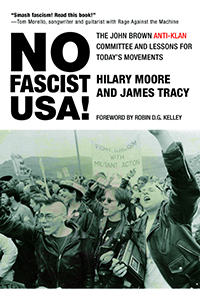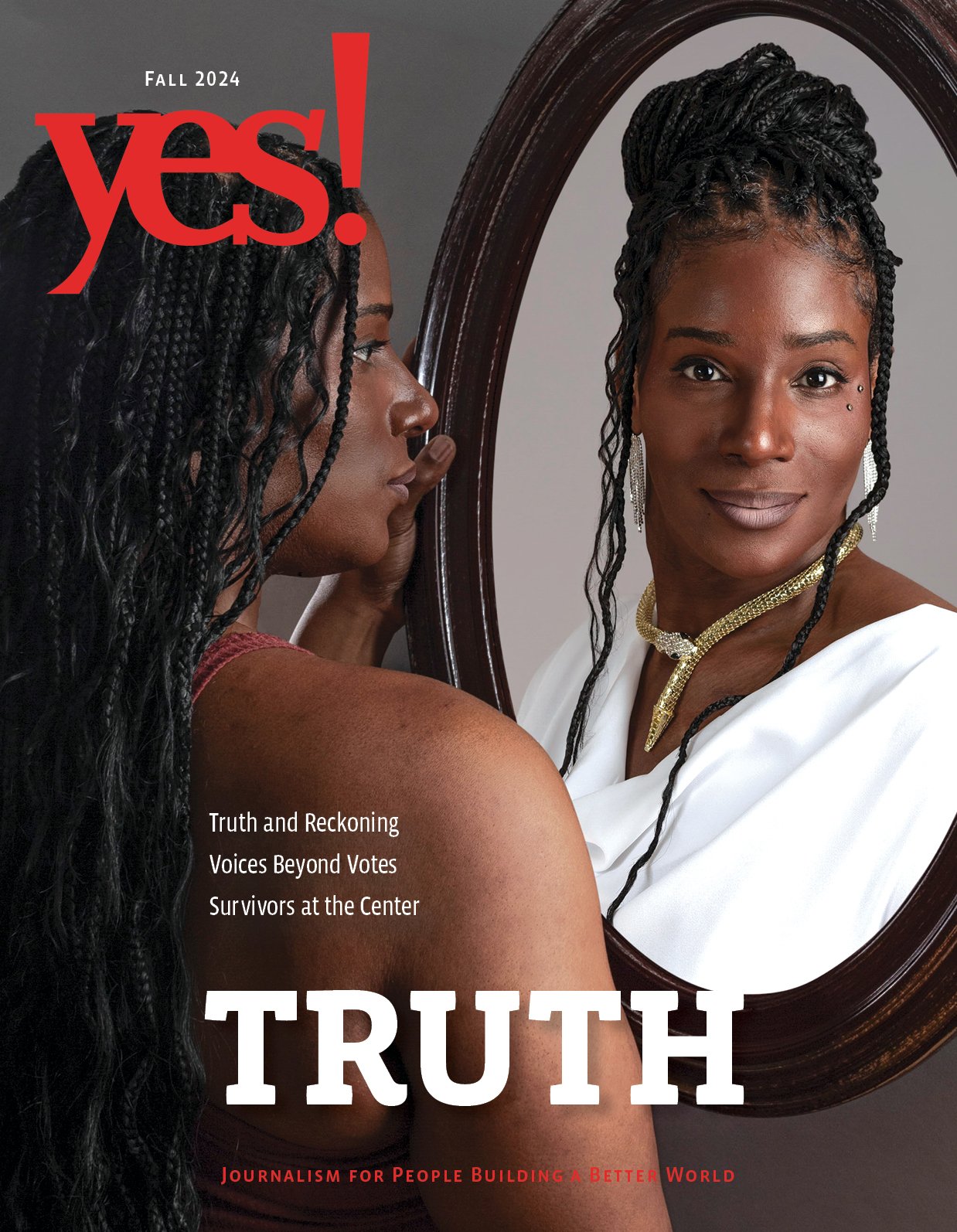Anti-Fascism Versus the Police, 1980s-Style

Anti-fascist and anti-racist organizing has taken many forms in the history of the United States. In No Fascist USA!, authors Hilary Moore and James Tracy tell the story of the John Brown Anti-Klan Committee, a grassroots network whose efforts in the 1980s were the groundwork for today’s movement against fascism and white supremacy.

In 1983, national headlines focused on a case brought by the NAACP against the city of Richmond, California, for excessive brutality by members of its police department. Known for its ports, shipyards, and railway system, Richmond was a highly segregated industrial city just north of Berkeley. In Richmond, Chevron’s oldest oil refinery and train tracks demarcated the mostly Black inner city and the Asian communities that have long called Richmond home. Inner Richmond contrasted starkly with the affluent, mostly white Richmond Hills area with its closer access to the coastline.
The Richmond Police Department had been known for its “tough” conduct, but in 1983 an actively organized white supremacist group inside the department known as “the Cowboys” was publicly exposed. The Cowboys had formed after Black rebellions in the early 1970s, around the same time that police departments were also developing SWAT teams and counterinsurgency units. Throughout 1982, 40 Black Richmond residents filed multiple allegations of police brutality, harassment, and arbitrary assault. The families of Johnny Roman, 25 years old, and Michael Guillory, 22 years old—two of the five Black men killed by Richmond Police Department over a three-year period—brought a civil trial against the City of Richmond on allegations of police misconduct and death by excessive force.
Prairie Fire Organizing Committee, in line with its priorities of supporting Black Liberation, created the Dare to Struggle Committee Against the Klan, a precursor to the John Brown Anti-Klan Committee in the Bay Area. The situation in Richmond called for concerted pushback. They first connected with the NAACP lawyers who were responsible for exposing police brutality in Oakland. Dare to Struggle placed the emergence of the Cowboys in a long historical continuum of white efforts to dominate and control Black people, beginning with the role of slave patrols in the era of settler-colonialism. The racist brutality of the Cowboys made this point apparent. “It was really awful,” Judy Siff recalled. “The Cowboys had created posters and shirts that compared somebody they killed to a deer. It was a game to them.”
Another Committee member, Judy Gerber, collected clippings in the daily newspaper relating to police violence and racism. “It was an enormous stack of articles. It was a jolt to me how many. That was huge in sharing with other groups and making our point concrete,” said Gerber. Using the clippings in their community outreach efforts, they were able to persuasively demonstrate how a culture of white supremacy pervaded Bay Area police departments and society at large. China Brotsky described how the group started a campaign to pressure the Richmond police chief—not because he was the only one in the department responsible for racism, but because going after him “would set a precedent.” Dare to Struggle intended to counter the classic argument of “a few bad apples” with an evidence-based case, supported by clippings, that proved chronic, system-wide corruption.
The testimonies during pretrial hearings revealed that police officers who were members of the Cowboy group were easily identified by the cowboy-style boots and hats they often wore, and by the fact that they often worked at night for the explicitly stated reason of wanting to be in on “more action.” Among the police identified as members of the Cowboys were Officers Clinton Mitchell and Samuel Dudkiewicz, along with Sergeants Frank Hanratty and Dennis Browne. What’s more, careful examination of the brutal shootings of Black people by white police, in addition to testimonies from Black police officers, pointed not only to an organized white supremacist group within the department, but also to a pervasively racist culture within the police department as a whole.
During the year before this case, five Black men were killed by the Richmond Police Department. Over the preceding three years, Black families looking to buy houses outside the “toxic triangle” near refineries were attacked by the Klan through numerous cross burnings, arson attacks, a car bombing, and an armed raid on a housing project. In 1981, when Black residents took to the streets to protest police brutality, they were met by robed Klan members in a “Support Your Local Police” counter-demonstration. This was also the year Tom Metzger announced that he would run as a “pro-white” candidate for the California Senate.
Brotsky, Siff, and Gerber were part of the Bay Area Prairie Fire chapter. Since 1980, they had been organizing support for Black Panther Geronimo Ji-Jaga Pratt while printing the newspaper Arm the Spirit, a publication of the prison abolition movement during the 1970s and 1980s. With the rise in police shootings of Black men around the region, particularly in the cities of Richmond and Concord, the Prairie Fire chapter continued its relationship with the New Afrikan Independence Movement on the West Coast. Soon, Brotsky, Siff, and Gerber formally adopted the “Stop Killer Cops!” campaign conducted by the John Brown network. After the 1981 Brinks debacle, Prairie Fire chapters in the Bay Area, Los Angeles, and Chicago, along with the Dare to Struggle committee in San Francisco, took up the work of building support and solidarity for the people who had been arrested. That work reconnected these anti-imperialist organizations in a stronger way with people in May 19th and the John Brown Anti-Klan Committee on the East Coast. Coupled with their growing understanding of the state of the white supremacist movement, the organizations agreed that the work would be stronger if they united into one national organization, so Dare to Struggle joined the John Brown group.
Through the “Stop Killer Cops!” campaign, the Committee members began working with the NAACP lawyers and community groups that were supporting the families of the two victims, Johnny Roman and Michael Guillory. First, they shared their research and findings—particularly information about racist attacks in the area—with lawyers working on the case. The NAACP told the group that it was a regular practice for the Cowboys to abduct young Black men in Richmond and then drop them off in affluent white suburbs, such as Pittsburg, a 45-minute car ride away. In such places, if the victims were not able to get back quickly, they would often be harassed and detained again by local police. The Committee realized they would be well suited to apply pressure in those very same affluent neighborhoods.
They began submitting articles in local newspapers pointing to the fact that many of Richmond’s police officers and key figures in the case, including Police Chief Leo Garfield and federal judge Robert Aguilar, did not live in the part of Richmond where the police had killed the men. This highlighted the contradiction that those responsible have a great deal of power in the case, could easily remove themselves, and were therefore disconnected from the daily onslaught of brutality. At the same time, Siff and Brotsky started visiting the suburban neighborhood of El Sobrante, where Police Chief Garfield lived, in order to gather information for planning a protest there.
On May 22, 1983, the group led an early morning demonstration outside Garfield’s home. Eighty people gathered there and chanted, “Chief Leo, you can’t hide, we charge you with genocide!” On a bullhorn, Barbara Jacobs, a Bay Area Committee member, announced their reason for being there: “He cannot return to the peace and quiet of the suburbs while he and his department are responsible for the murder and brutality of the Black community on a daily basis.” While in Garfield’s neighborhood, the John Brown crew talked to his neighbors about his lack of oversight of the Cowboys and how it was impacting the Black community in Richmond.
During this period, the Bay Area chapter began creating more opportunities for people to join in their efforts. Members started the “Run Against the Klan!” 5K run, which became an annual event. “It was much broader, in terms of who would show up, than some of the other programs we were doing,” said Roth. They created radio announcements broadcast on local stations. One hit included Committee members talking about the event while running and out of breath. Over the course of five annual marathons, hundreds of people participated in the run around Oakland’s Lake Merritt wearing T-shirts that had a picture of a Klansman with a sneaker print on his hood. The money raised from the marathons went toward printing, supporting other anti-Klan demonstrations, and funding speaking events with members of the New African Peoples Organization and other activists from the Black Liberation Movement, like the Republic of New Afrika.
As community pressure was building, the federal judge hurried the case by ordering the city of Richmond and the families of Roman and Guillory to settle outside of court. Richmond’s city council refused to settle out of court and rejected an initial resignation from Police Chief Garfield. The John Brown crew interpreted this as a vote of confidence for the defense and a green light for the Cowboys. However, when the trial went forth, on June 3, 1983, the judge found the Richmond Police Department guilty of “patterns and practice” of racial violence and awarded $3 million in damages to the families of Roman and Guillory. One week later, Chief Garfield turned in his resignation.
In the 1983 April issue of the newspaper Death to the Klan!, the Bay Area chapter argued that “nothing has fundamentally changed” in the terrain of white supremacy. The Cowboys were still employed as police officers in the city of Richmond. But what was changing was the Committee’s approach to resistance. The Bay Area group was an example, where, without compromising its politics, a chapter began working with organizations such as the NAACP that had political views and tactics very different from their own. The Committee experimented with using multiple strategies that got results, as in the small victories against police brutality in Richmond. This kind of experimentation was uneven across chapters, and at times at odds with the organization’s own rhetoric, but it signaled a reckoning with vestiges of the sectarianism that the Committee was born into. In the years after the fight against the Cowboys, the Bay Area chapter started the “Just Say No to Nazis” campaign, a play on Nancy Reagan’s “Just Say No to Drugs” campaign.
From No Fascist USA!: The John Brown Anti-Klan Committee and Lessons for Today’s Movements. Copyright © 2020 by Hilary Moore and James Tracy. Reprinted with the permission of City Lights Books.
|
James Tracy
is a Bay Area native and a community organizer. He is co-founder of the San Francisco Community Land Trust and is on staff at Community Housing Partnership. He is the author of Dispatches Against Displacement: Field Notes From San Francisco’s Housing Wars, as well as co-author of Hillbilly Nationalists, Urban Race Rebels and Black Power: Community Organizing in Radical Times.
|
|
Hilary Moore
is an anti-racist political educator and teaches with generative somatics. She works on the Leadership Team of Showing Up for Racial Justice, and is the co-author Lessons for Today's Movements (City Lights, 2020) and Organizing Cools the Planet: Tools and Reflections to Navigate the Climate Crisis (PM Press, 2011). Her newest book is Burning Earth, Changing Europe: How the Racist Right Exploits the Climate Crisis—And What We Can Do About It (Rosa Luxemburg Stiftung- Brussels, 2020).
|







